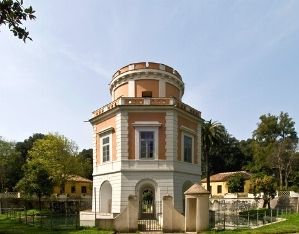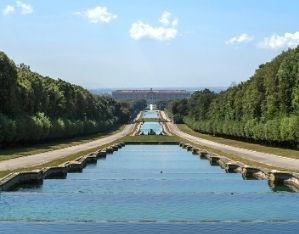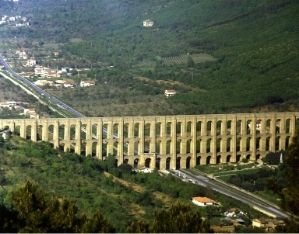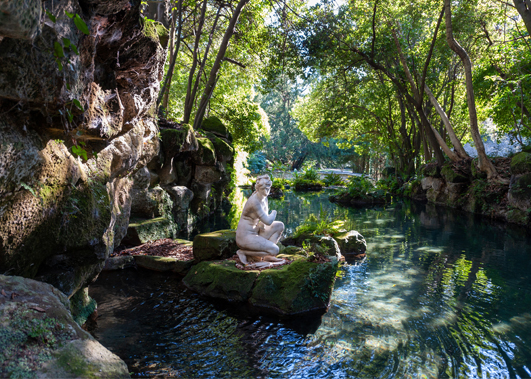The Royal Palace and adjoining park are among the world’s largest and most famous monumental complexes. In 1997, along with San Leucio and the Carolino Aqueduct, it was awarded UNESCO “World Heritage List” status.
Work began on this monumental complex in 1752 at the behest of Charles of Bourbon, who was keen to create “a second capital” in Caserta, connecting the city to the local area and Naples via parks and gardens, kilometres of straight roads and navigable canals. Despite its extensive size, he wanted the Park to be an exquisitely ornamental palace garden, inevitably in competition with the magnificence of Versailles. Luigi Vanvitelli created what is rightly considered to be the last great utopia built by a European royal dynasty. The pre-existing landscape and its morphology inspired the design’s underlying nature: an agrarian plain on which the Park and the long Via d’Acqua with six fountains and a rich statuary develop, along with a hill on which a fountain-waterfall was built. The Peschiera Grande and the Castelluccia building line the left-hand side of its large central avenue; in dialectic relation to the Park, the English Garden is located to the right, towards the top. Commissioned by Queen Maria Carolina as advised by Sir William Hamilton, the English garden was built between 1786 and 1798 by gardener and botanist John Andrew Graefer; Carlo Vanvitelli designed the buildings. Consistent with the idea of an informal garden, it was conceived as a fragment of natural landscape embellished with refined architecture and waterworks, resulting in ponds with statuary (for example, Tommaso Solari’s Venus), artificial ruins of small temples, the mysterious Cryptoporticus, greenhouses, and large buildings such as the Aperia. Among reliefs and mini-valleys, an esoteric path commissioned by the Queen starts from the Cryptoporticus’s dark corridor and runs past Mitteleuropean- and Neapolitan-style masonic lodges.
Highlights

The Castelluccia
In 1769, the old Pernesta Tower, built originally by the Acquaviva princes, was renovated and adapted to be used for young King Ferdinand’s military training and play. Octagonal in shape, it is surrounded by a moat, several pavilions and a garden filled with exotic plants. Its current neoclassical appearance dates back to work carried out in 1818.

The Via d'Acqua
The Via d’Acqua waterway runs for more than 3 km, following a route interspersed with meadows, pools and fountains. Scenographically, the composition concludes with a waterfall that runs down Mount Briano; the Aeolus, Dolphins, Ceres, Venus and Adonis, and Diana and Actaeon Fountains convey an evident symbolic meaning in their explicit reference to Ovid’s Metamorphoses.

Parterre and Old Wood
So named because it existed before the Reggia was built, the Old Wood stands to the left of the large central parterre, which ends in an exedra. By the end of the 16th century, it had already become a garden for the Acquaviva d’Aragona palace. The property then passed on to the Caetani di Sermoneta, before it was taken over by Charles of Bourbon. Luigi Vanvitelli kept faith with the former avenue layout, adding holm oak vegetation.

Caroline Aqueduct
Commissioned by Charles of Bourbon, the aqueduct was built in 1753 by Luigi Vanvitelli to supply the Royal Palace, the city and the Carditello estate, as well as to improve water supply to Naples. The conduit begins at the Airola springs and runs for 38 km underground; the only external section is at Ponti della Valle in Maddaloni, which has three levels of 67 arches and pillars.
Find out more
GREAT WOMEN, GREAT GARDENS
A wide-eyed, intelligent and ambitious woman, educated at the Viennese court, in 1768 she married Ferdinand IV by proxy, directing the political direction of the court.

 Reggia di Caserta
Contacts
Reggia di Caserta
Contacts
Contacts
Telephone:+39 0823 1491211
Other contacts::ticket office: +39 0823 448084
Address
Piazza Carlo di Borbone
81100, Caserta (CE)

Ministero per i beni e le attività culturali e per il turismo
 Reggia di Caserta
Opening times and prices
Reggia di Caserta
Opening times and prices
Opening hours
The Royal Palace of Caserta is open every day except Tuesdays, December 25 and January 1.
Special openings on Tuesdays: December 8, 22 and 29, 2020.
The Royal Palace (Royal Apartments)
- from 9.30 am to 7.30 pm
- ticket office closing: 6.45 pm; last entry: 7.00 pm; museum exit 7.25 pm
Royal Park and English Garden
- opening at 8.30 am
- For more information about closing times please consult the website.
Court Theatre
It is possible to visit the Court Theatre of the Reggia with guided tours organized by the Italian Touring Club:
- Fridays: 10.00 am – 1.00 pm (last admission 12.45)
- Saturday: 10.00 am – 1.00 pm (last admission 12.45)
- Sunday: 10.00 am – 1.00 pm (last admission 12.45)
Pricing
- Entire Park+Apartments (to visit the Royal Apartments, Royal Park and English Garden): € 14,00
- Entire Park (to visit the Royal Park and the English Garden): € 9,00
- Entire Apartments (to visit the Royal Apartments. It can be purchased when the Royal Park is closed): € 10,00
- Evening Apartments (to visit the Royal Apartments. It can be purchased from 5pm): € 3,00
- Reduced price Park+Apartments EU citizens 18-24 years old (for EU citizens between 18 and 24 years old to visit Royal Apartments, Royal Park and English Garden, compatibly with the opening hours of the Royal Park and English Garden): € 2,00
- Park+Apartments (for those under 18 years of age and entitled to discounts for visiting the Royal Park and the Royal Apartments): free entrance
Subscriptions
- The Royal Palace of Caserta has established the “Reggia REstart” season ticket. At the price of € 17.00 (including pre-sale and commission costs) the Royal Apartments, the Royal Park and the English Garden can be visited until 31 December 2020.
Purchase and reservation required. For information on reductions and benefits consult the website.
 Reggia di Caserta
How to get there
Reggia di Caserta
How to get there
Address
Piazza Carlo di Borbone
81100, Caserta (CE)
Latitude: 41.073392
Longitude: 14.327036
How to arrive by road
- From the A1 (Milan-Naples) take the exit Caserta nord.
- From the A30 take the Caserta sud exit.
Municipal basement car park in Piazza Carlo di Borbone (near the railway station).
How to arrive by train
From the station of Caserta is about 5 minutes walk, through the square in front of the Royal Palace.
Reggia Express
How to arrive by bus
- The
hours
of the CLP provincial routes to the Royal Palace of Caserta. - The
hours
of the bus from Afragola AV station to Caserta. - The service is also available
City Sightseeing
with shuttle Naples – Royal Palace of Caserta
How to arrive on foot
The Royal Palace of Caserta is within walking distance from Caserta Station. In about 5 minutes, crossing Piazza Carlo di Borbone, you arrive at the Royal Palace.
Additional directions
A transport service is available within the park of the Reggia. The cost is € 2.50 including return trip. The service is entrusted in concession.
 Reggia di Caserta
Services/Accessibility
Reggia di Caserta
Services/Accessibility
Services
At the Royal Palace of Caserta there are two refreshment points:
- a refreshment bar in the Cannocchiale, at the entrance to the Royal Park
- a restaurant in the Royal Park, at the end of the Waterway, near the Fountain of Diana and Actaeon.
Guided tours and educational activities
- Visits and educational activities for schools are subject to compulsory booking and include numerous possibilities for tours and educational workshops. For information and bookings consult the website
- Audio guides are available in Italian, English, French, German and Spanish. The cost is € 5 per person.
- Earphones-silencer € 2,00 per person upon authorization for a guided group with more than 6 visitors.
The bookshop of the Royal Palace, located at the entrance next to the ticket office, allows you to buy various types of books such as the official guide of the Royal Palace of Caserta, exhibition catalogues, art catalogues, children's literature, books on local history as well as souvenirs and various objects.
Toilets are available in the Park, on the Ground Floor and in the Historical Apartments (with changing table).
- Bike hourly rate € 4,00
- Hourly rate pedal assisted bicycle € 6,00
- Child seats approved for up to 15 kg are available.
Accessibility
Assistance for the disabled is provided by staff located at the entrance to the Reggia; to take advantage of this assistance, please contact the staff at the ticket office.
 Reggia di Caserta
Private events
Reggia di Caserta
Private events
The carrying out of initiatives by private parties within the spaces of the Reggia is bound by the following regulations.
 Reggia di Caserta
Itineraries
Reggia di Caserta
Itineraries
You could find the garden in these itineraries
 Favorite saving result
Favorite saving result
 Warning!
Warning!
You've have to sign up or sign in to add this element to your favorites.
